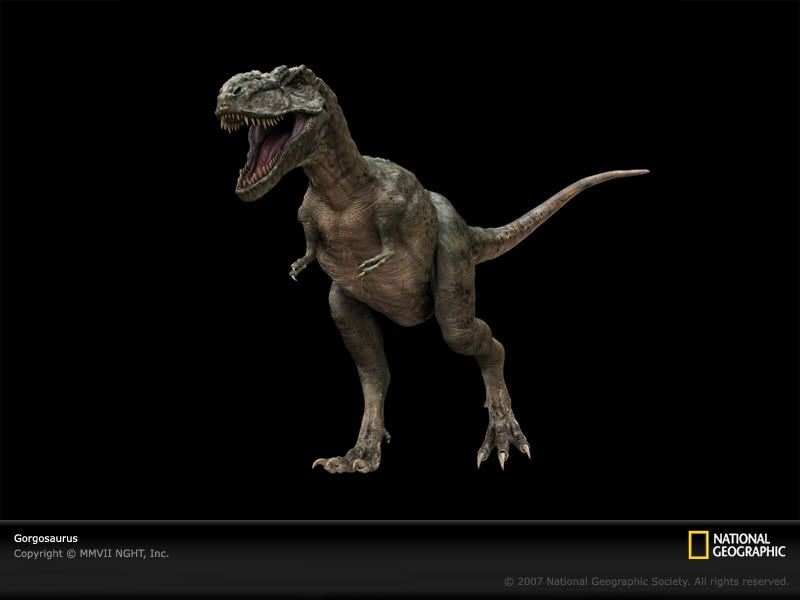Post by dinosauria101 on Jul 13, 2019 18:17:50 GMT 5
Gorgosaurus libratus
Gorgosaurus is a genus of tyrannosaurid theropod dinosaur that lived in western North America during the Late Cretaceous Period, between about 76.5 and 75 million years ago. Fossil remains have been found in the Canadian province of Alberta and possibly the U.S. state of Montana. Paleontologists recognize only the type species, G. libratus, although other species have been erroneously referred to the genus. Like most known tyrannosaurids, Gorgosaurus was a bipedal predator weighing more than a metric ton as an adult; dozens of large, sharp teeth lined its jaws, while its two-fingered forelimbs were comparatively small. Gorgosaurus was most closely related to Albertosaurus, and more distantly related to the larger Tyrannosaurus. Gorgosaurus was smaller than Tyrannosaurus or Tarbosaurus, closer in size to Albertosaurus and Daspletosaurus. Adults reached 8 to 9 m (26 to 30 ft) from snout to tail. Paleontologists have estimated full-grown adults to weigh about 2.5 tonnes (2.8 short tons), perhaps approaching 2.8–2.9 tonnes (3.1–3.2 short tons). The largest known skull measures 99 cm (39 in) long, just slightly smaller than that of Daspletosaurus.

Styracosaurus albertensis
Styracosaurus (meaning "spiked lizard" from the Ancient Greek styrax/στύραξ "spike at the butt-end of a spear-shaft" and sauros/σαῦρος "lizard") is a genus of herbivorous ceratopsian dinosaur from the Cretaceous Period (Campanian stage), about 75.5 to 75 million years ago. It had four to six long parietal spikes extending from its neck frill, a smaller jugal horn on each of its cheeks, and a single horn protruding from its nose, which may have been up to 60 centimetres (2.0 feet) long and 15 centimetres (5.9 inches) wide. The function or functions of the horns and frills have been debated for many years. Styracosaurus was a relatively large dinosaur, reaching lengths of 5.5 metres (18 feet) and weighing nearly 3 tonnes. It stood about 1.8 meters (5.9 feet) tall. Styracosaurus possessed four short legs and a bulky body. Its tail was rather short. The skull had a beak and shearing cheek teeth arranged in continuous dental batteries, suggesting that the animal sliced up plants. Like other ceratopsians, this dinosaur may have been a herd animal, travelling in large groups, as suggested by bonebeds.

Credit to Wikipedia
Gorgosaurus is a genus of tyrannosaurid theropod dinosaur that lived in western North America during the Late Cretaceous Period, between about 76.5 and 75 million years ago. Fossil remains have been found in the Canadian province of Alberta and possibly the U.S. state of Montana. Paleontologists recognize only the type species, G. libratus, although other species have been erroneously referred to the genus. Like most known tyrannosaurids, Gorgosaurus was a bipedal predator weighing more than a metric ton as an adult; dozens of large, sharp teeth lined its jaws, while its two-fingered forelimbs were comparatively small. Gorgosaurus was most closely related to Albertosaurus, and more distantly related to the larger Tyrannosaurus. Gorgosaurus was smaller than Tyrannosaurus or Tarbosaurus, closer in size to Albertosaurus and Daspletosaurus. Adults reached 8 to 9 m (26 to 30 ft) from snout to tail. Paleontologists have estimated full-grown adults to weigh about 2.5 tonnes (2.8 short tons), perhaps approaching 2.8–2.9 tonnes (3.1–3.2 short tons). The largest known skull measures 99 cm (39 in) long, just slightly smaller than that of Daspletosaurus.

Styracosaurus albertensis
Styracosaurus (meaning "spiked lizard" from the Ancient Greek styrax/στύραξ "spike at the butt-end of a spear-shaft" and sauros/σαῦρος "lizard") is a genus of herbivorous ceratopsian dinosaur from the Cretaceous Period (Campanian stage), about 75.5 to 75 million years ago. It had four to six long parietal spikes extending from its neck frill, a smaller jugal horn on each of its cheeks, and a single horn protruding from its nose, which may have been up to 60 centimetres (2.0 feet) long and 15 centimetres (5.9 inches) wide. The function or functions of the horns and frills have been debated for many years. Styracosaurus was a relatively large dinosaur, reaching lengths of 5.5 metres (18 feet) and weighing nearly 3 tonnes. It stood about 1.8 meters (5.9 feet) tall. Styracosaurus possessed four short legs and a bulky body. Its tail was rather short. The skull had a beak and shearing cheek teeth arranged in continuous dental batteries, suggesting that the animal sliced up plants. Like other ceratopsians, this dinosaur may have been a herd animal, travelling in large groups, as suggested by bonebeds.

Credit to Wikipedia





